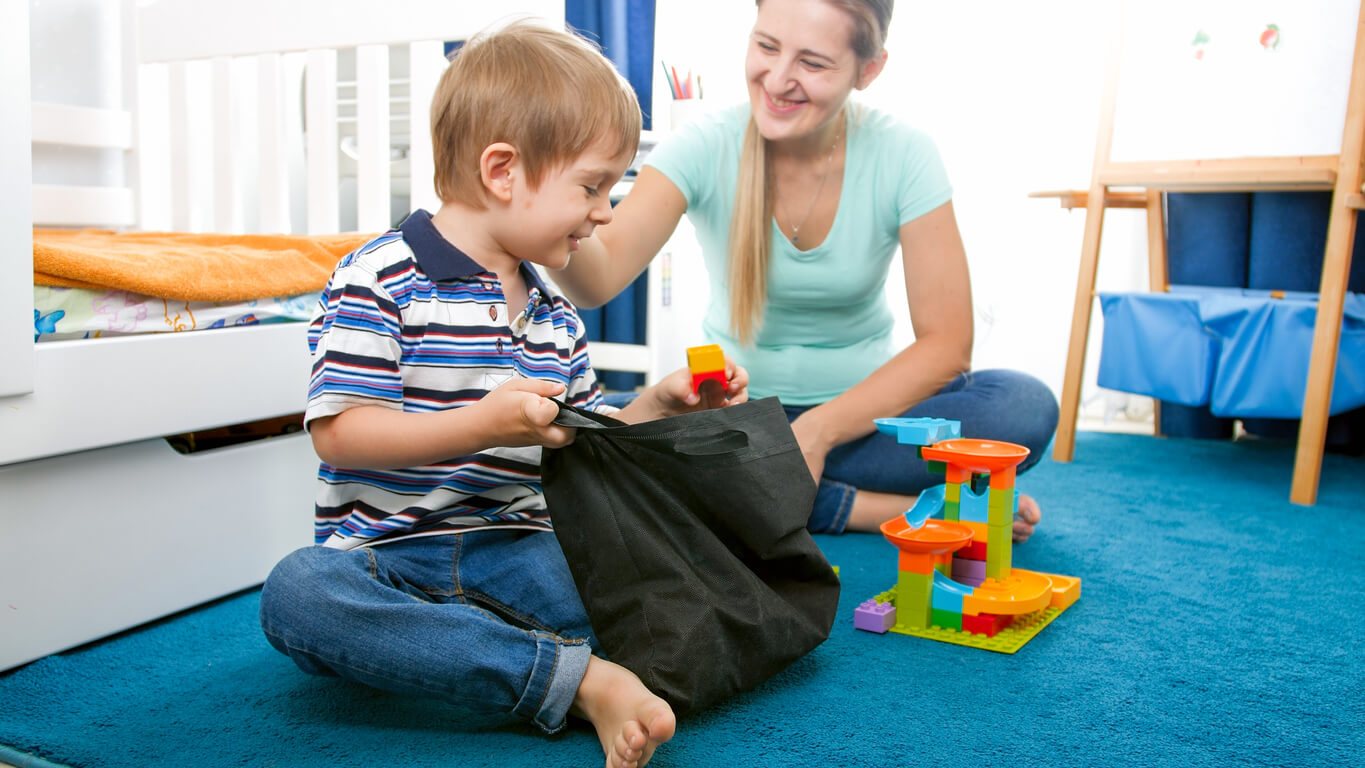The ABA Method for Autism


Written and verified by the psychologist Elena Sanz Martín
Autism spectrum disorders (ASD) have a great impact on family dynamics. Parents of children with this condition are often confused and disoriented, especially in the early years of their children’s lives. They don’t always have sufficient and clear information and may even find themselves faced with a bombardment of the techniques, methods, and treatments available to choose from. The ABA method has scientific backing and has given good results in autism, although it also has its detractors. Therefore, we want to tell you all about it so that you can draw your own conclusions.
It’s worth mentioning that it’s an intensive program with a therapeutic load of 20 to 40 hours per week. This implies a cost that makes it inaccessible for many people. Even so, its methods and procedures can be used without necessarily carrying out the complete intervention.
Preferably, the ABA method should be applied in young children, as better results can be obtained when it’s started at an early age. If you want to know more, keep reading!
What is the ABA method?
The ABA method is a therapeutic intervention program for certain neurodevelopmental and behavioral disorders, as well as intellectual disabilities. Its acronym stands for Applied Behavior Analysis.
It’s based on procedures aimed at modifying behavior, which can be very varied. The objective is to observe, describe, and predict the child’s behavior in order to replace non-functional aspects with more adaptive ones.
In this way, disruptive behaviors and learning difficulties are addressed. Even new skills are taught to facilitate the development and autonomy of children with autism.

However, the ABA method presents some distinctive and particular characteristics:
- It’s a personalized and individualized treatment, which focuses on the specific needs of each child.
- It’s based mainly on repetition and the use of positive reinforcement.
- Supports are offered during the intervention and are gradually withdrawn.
- A daily record of the child’s progress is kept, which is very useful for parents, teachers, and therapists.
- It’s a very structured program in which small achievable goals are established for the child, which progressively increase in difficulty.
- It seeks to offer the child all the necessary help to succeed in the task or skill to be developed. Therefore, frustration is avoided and motivation is increased, in addition to increasing personal safety.
What does the ABA method for autism work on?
The ABA method employs various techniques, tools, and procedures that have solid scientific support. Therefore, it’s applied to different areas of the child’s daily life and seeks to offer a comprehensive treatment that includes all the usual environments. It’s common to start at home, but soon, the skills learned are generalized to other contexts.
Among the main areas of application are the following:
- Cognitive skills: Those functions that allow the relationship with the environment and learning, such as attention, memory, or abstract thinking.
- Academic skills: Related to the ability to learn and to succeed in school. They range from time planning to study skills.
- Social skills: Help the child to relate and communicate with others, both verbally and non-verbally (e.g., working on eye contact).
- Fine and gross psychomotor skills.
- Self-care: Teaches personal hygiene routines or eating habits, among others.
- Household chores: Autonomy and collaboration in household tasks, such as sweeping, setting the table, or making the bed, are facilitated.
- Impulse control: The relationship between stimuli and reactions is observed in order to control behavior.

The ABA method and its detractors
Although this program has proven to be effective and many families attest to its positive results, more and more patients and professionals are showing their reluctance about it. First of all, the method is criticized for excessive repetition and the wear and tear it can generate in children.
It’s also considered not very respectful of the patient’s own essence. As the objective is to modify behavior, the real source of the problem may not be addressed. For example, if the child’s disruptive behavior is due to their high sensitivity, there’s no point in addressing the behavioral level if the sensory aspect isn’t addressed. Somehow, it seems that the aim is to make these children behave in a neurotypical way, instead of respecting their neurodiversity.
In short, this is one of the therapeutic alternatives available for autism that has been shown to offer good results, but it may not be the most appropriate option for all families. Be well informed and look for the most appropriate approach for your child.
Autism spectrum disorders (ASD) have a great impact on family dynamics. Parents of children with this condition are often confused and disoriented, especially in the early years of their children’s lives. They don’t always have sufficient and clear information and may even find themselves faced with a bombardment of the techniques, methods, and treatments available to choose from. The ABA method has scientific backing and has given good results in autism, although it also has its detractors. Therefore, we want to tell you all about it so that you can draw your own conclusions.
It’s worth mentioning that it’s an intensive program with a therapeutic load of 20 to 40 hours per week. This implies a cost that makes it inaccessible for many people. Even so, its methods and procedures can be used without necessarily carrying out the complete intervention.
Preferably, the ABA method should be applied in young children, as better results can be obtained when it’s started at an early age. If you want to know more, keep reading!
What is the ABA method?
The ABA method is a therapeutic intervention program for certain neurodevelopmental and behavioral disorders, as well as intellectual disabilities. Its acronym stands for Applied Behavior Analysis.
It’s based on procedures aimed at modifying behavior, which can be very varied. The objective is to observe, describe, and predict the child’s behavior in order to replace non-functional aspects with more adaptive ones.
In this way, disruptive behaviors and learning difficulties are addressed. Even new skills are taught to facilitate the development and autonomy of children with autism.

However, the ABA method presents some distinctive and particular characteristics:
- It’s a personalized and individualized treatment, which focuses on the specific needs of each child.
- It’s based mainly on repetition and the use of positive reinforcement.
- Supports are offered during the intervention and are gradually withdrawn.
- A daily record of the child’s progress is kept, which is very useful for parents, teachers, and therapists.
- It’s a very structured program in which small achievable goals are established for the child, which progressively increase in difficulty.
- It seeks to offer the child all the necessary help to succeed in the task or skill to be developed. Therefore, frustration is avoided and motivation is increased, in addition to increasing personal safety.
What does the ABA method for autism work on?
The ABA method employs various techniques, tools, and procedures that have solid scientific support. Therefore, it’s applied to different areas of the child’s daily life and seeks to offer a comprehensive treatment that includes all the usual environments. It’s common to start at home, but soon, the skills learned are generalized to other contexts.
Among the main areas of application are the following:
- Cognitive skills: Those functions that allow the relationship with the environment and learning, such as attention, memory, or abstract thinking.
- Academic skills: Related to the ability to learn and to succeed in school. They range from time planning to study skills.
- Social skills: Help the child to relate and communicate with others, both verbally and non-verbally (e.g., working on eye contact).
- Fine and gross psychomotor skills.
- Self-care: Teaches personal hygiene routines or eating habits, among others.
- Household chores: Autonomy and collaboration in household tasks, such as sweeping, setting the table, or making the bed, are facilitated.
- Impulse control: The relationship between stimuli and reactions is observed in order to control behavior.

The ABA method and its detractors
Although this program has proven to be effective and many families attest to its positive results, more and more patients and professionals are showing their reluctance about it. First of all, the method is criticized for excessive repetition and the wear and tear it can generate in children.
It’s also considered not very respectful of the patient’s own essence. As the objective is to modify behavior, the real source of the problem may not be addressed. For example, if the child’s disruptive behavior is due to their high sensitivity, there’s no point in addressing the behavioral level if the sensory aspect isn’t addressed. Somehow, it seems that the aim is to make these children behave in a neurotypical way, instead of respecting their neurodiversity.
In short, this is one of the therapeutic alternatives available for autism that has been shown to offer good results, but it may not be the most appropriate option for all families. Be well informed and look for the most appropriate approach for your child.
All cited sources were thoroughly reviewed by our team to ensure their quality, reliability, currency, and validity. The bibliography of this article was considered reliable and of academic or scientific accuracy.
- Mulas, F., Ros-Cervera, G., Millá, M. G., Etchepareborda, M. C., Abad, L., & Téllez de Meneses, M. (2010). Modelos de intervención en niños con autismo. Rev Neurol, 50(3), 77-84.
- Peters-Scheffer, N., Didden, R., Korzilius, H., & Sturmey, P. (2011). A meta-analytic study on the effectiveness of comprehensive ABA-based early intervention programs for children with autism spectrum disorders. Research in Autism Spectrum Disorders, 5(1), 60-69.
This text is provided for informational purposes only and does not replace consultation with a professional. If in doubt, consult your specialist.








